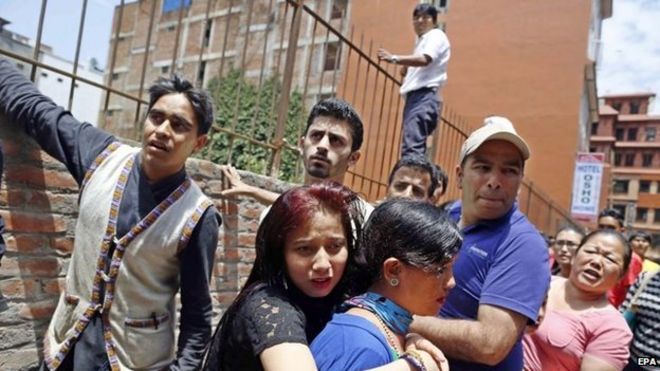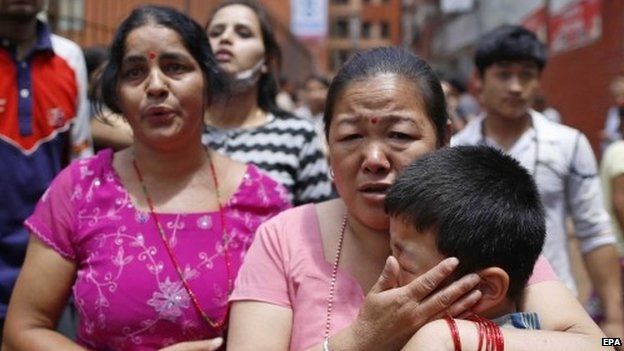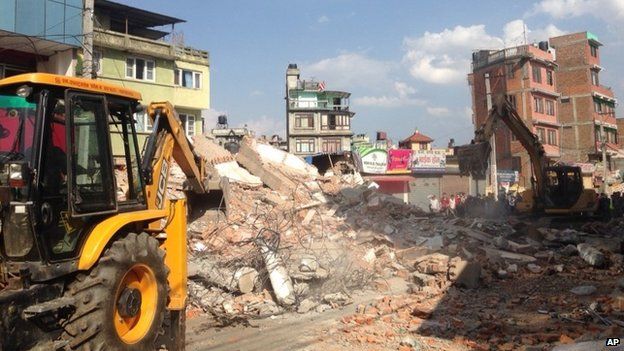Nepal earthquake, magnitude 7.3, strikes near Everest
- 28 minutes ago
- Asia

A major earthquake has struck eastern Nepal, near Mount Everest, two weeks after more than 8,000 died in a devastating quake.
At least 29 people have been killed and 1,006 injured, according to the Nepali government.
The latest earthquake hit near the town of Namche Bazaar, near Mount Everest.
The US Geological Survey said it had a magnitude of 7.3. An earthquake on 25 April, centred in western Nepal, had a magnitude of 7.8.
The latest tremor was also felt in northern India and Bangladesh, and was centred east of the Nepalese capital Kathmandu, in a rural area close to the Chinese border.
Follow the latest developments on our live page
In Kathmandu, which was badly damaged last month, people rushed out of buildings as the quake struck at 12:35 local time (06:50 GMT).
Rescue helicopters have been sent to districts north-east of the capital, that are believed to be worst hit.
A spokesman for Nepal's government told the BBC that 31 of the country's 75 districts had been affected.

At the scene: Simon Cox, BBC, Kathmandu
You could feel it really strongly. It went on for about 25 seconds - the ground was shaking, the birds started squawking, you could feel the buildings shaking.
There was another aftershock and people were all out on the street. That aftershock really added anxiety and panic. People started crying.
They are calm but you can tell they are all scared.

The BBC's Yogita Limaye, who was in Nepal's mountains when the latest earthquake struck, said: "The earth shook and it shook for a pretty long time.
"I can completely understand the sense of panic. We have been seeing tremors: it's been two-and-a-half weeks since the first quake. But this one really felt like it went on for a really long time. People have been terrified."


At least four people were killed in the town of Chautara, east of Kathmandu, where a number of buildings are reported to have collapsed.
The International Organisation for Migration said bodies were being pulled from rubble there.
Krishna Gyawali, the chief district officer for Chautara, said there had been a number of landslides.

The quake struck at a depth of 15km (9.3 miles), according to the US Geological Survey - the same depth as the April 25 quake. Shallow earthquakes are more likely to cause more damage at the surface.
Tuesday's earthquake is likely to be one of the largest to hit Nepal, which has suffered hundreds of aftershocks since 25 April.
The 7.3 quake was followed by six aftershocks of magnitude 5.0 or higher.
One tremor that hit 30 minutes later, centred on the district of Ramechhap, east of Kathmandu, had a magnitude of 6.3.Jump media player
 Analysis: Jonathan Amos, science correspondent, BBC News
Analysis: Jonathan Amos, science correspondent, BBC News
Scientists are already producing some preliminary analyses of Tuesday's quake.
The epicentre this time is about 80km (50 miles) east-north-east of Kathmandu, halfway to Everest. On 25 April, the big quake began 80km to the north-west of the capital.
In April, we saw the fault boundary rupture eastwards for 150km (93 miles). And the immediate assessment suggests Tuesday's tremor has occurred right at the eastern edge of this failure.
In that context, this second earthquake was almost certainly triggered by the stress changes caused by the first one. Indeed, the US Geological Survey had a forecast for an aftershock in this general area.
Its modelling suggested there was 1-in-200 chance of a M7-7.8 event occurring this week. So, not highly probable, but certainly possible.
Quake experts often talk about "seismic gaps", which refer to segments of faults that are, to some extent, overdue a quake. Tuesday's big tremor may well have filled a hole between what we saw on 25 April and some historic events - such as those in 1934, that occurred further still to the east.
No comments:
Post a Comment